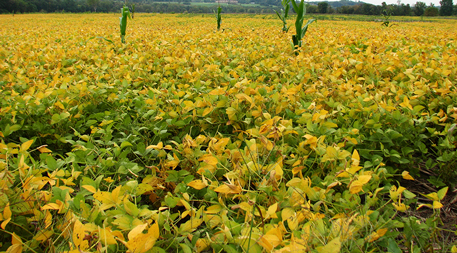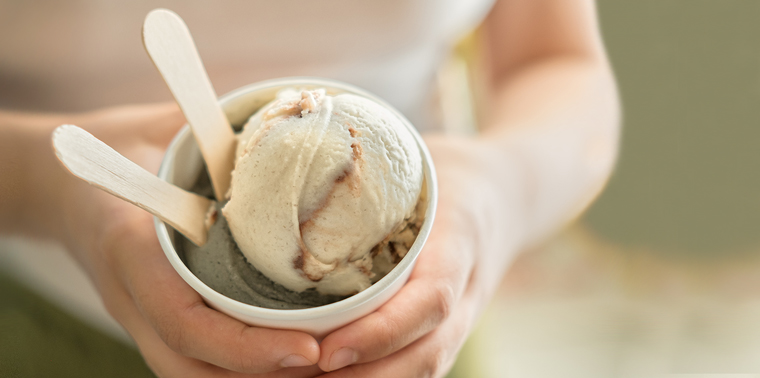December 19, 2017 — It was the spring of 1978 and I was 7 years old when the first scoops of Ben & Jerry’s ice cream were sold in Burlington, Vermont, about an hour from the rural home I shared with my parents and infant sister. I don’t remember when I got my first taste, but it probably wasn’t long after that, and it was the beginning of a nearly four-decade love affair that continues to this day.
Two years before the first Ben & Jerry’s scoop shop opened, the U.S. food system saw another first: The introduction of the herbicide glyphosate, commonly sold under the trade name Roundup. Glyphosate was introduced in the U.K. and Malaysia in 1974, but didn’t gain regulatory approval in North America until 1976, where it quickly earned favor in the agricultural industry for its weed-killing abilities. In the mid-1990s, genetically modified, glyphosate-resistant soybeans were introduced (other crops, including corn, canola, alfalfa and sorghum soon followed), allowing for broad-spectrum applications of the herbicide throughout the growing season and resulting in a massive uptick in use that, like my fondness for premium ice cream, continues unabated.
Another use that few consumers are aware of also has contributed to increased glyphosate use: Pre-harvest crop desiccation. Originating in Scotland in the 1980s, this practice involves applying the herbicide to a standing crop toward the end of the growing season with the express purpose of expediting the natural process that would occur, where a crop slowly dies and dries in the field. The glyphosate kills the crop so it can be dry enough to harvest sooner than if it were left to die naturally — allowing the farmer to clear the field before the onset of unfavorable weather. Given how long they are usually in storage, the moisture levels of grain crops need to be low enough to store without getting moldy. The practice has since gained significant traction in North America, particularly in the northern regions of the Great Plains and the grain belt of Midwestern and western Canada, where cold, wet weather comes early.
For these farmers glyphosate-induced pre-harvest crop desiccation provides a couple other advantages. The accelerated drying process reduces potential post-harvest energy inputs, such as the need to use a grain dryer. The practice also generates a physiological “last gasp” response in less mature plants that expedites ripening and helps them “catch up” to their companions, ensuring more consistent yields. This in turn allows successive crops to be sowed earlier and improves weed control.

In addition to speeding crop drying, glyphosate can help synchronize ripening in plants at harvest time. Photo courtesy of bobistraveling
Currently, few statistics exist regarding the acreage subject to glyphosate desiccation or the overall quantity of glyphosate use for drying, but there’s little doubt that the practice is expanding across a variety of crops including corn, peas, soybeans, flax, rye, lentils, triticale, buckwheat, canola, millet, potatoes, sugar beets, soybeans and other edible legumes.
As a result, glyphosate has been showing up in trace amounts in food — including Ben & Jerry’s ice cream — raising red flags among consumer groups and even causing companies to change their sourcing to avoid contamination.
The exact timing of the application depends on a number of factors, but generally ranges from three to seven days before the onset of harvesting activities. And herein lies a potential explanation for the appearance of glyphosate in Ben & Jerry’s, as well as a large number of other food products. “Pre-harvest desiccation may account for only a small percentage of overall glyphosate use,” says Charles Benbrook, a visiting scholar at the Bloomberg School of Public Health who has spent more than a decade studying the use of glyphosate and associated health risks. “But it accounts for over 50 percent of dietary exposure.”
Health Concerns
So what? That depends on whom you ask. The accepted regulatory stance is that glyphosate is relatively benign; indeed, in 2015 the U.S. Environmental Protection Agency increased threshold levels in both oats and wheat; in the case of oats, the allowable threshold for final processed grain was raised from 0.1 parts per million (ppm) to 30 ppm. For its part, Monsanto claims that glyphosate poses no health risk when used according to label instructions. And, in December 2017, the EPA released a draft human health risk assessment stating that glyphosate is not likely to be carcinogenic to humans, or present other meaningful risks, assuming the product is used according to labeling instructions — supporting Monsanto’s long-held position.
“There never has been, and still to this day there remains, not much certainty regarding the health risks associated with glyphosate.” – Charles BenbrookNot everyone agrees that glyphosate is as innocuous as its manufacturer and the EPA would have us believe, however. The World Health Organization, for one, has classified it as a possible carcinogen, as has the state of California. And although the European Union recently voted to reauthorize the use of glyphosate, license was granted for only five years, rather than the 15 years sought.
“There never has been, and still to this day there remains, not much certainty regarding the health risks associated with glyphosate,” says Benbrook.
Stephanie Seneff, a senior research scientist at the Massachusetts Institute of Technology, suspects there is a link between increased uses of glyphosate — largely via the process of pre-harvest desiccation — and celiac disease, which has increased dramatically in recent years, particularly among adolescents. “Wheat-based products are showing up with a lot of glyphosate on them, and glyphosate interferes with protein digestion,” says Seneff (celiac disease is triggered by gluten, a protein).
No matter whose version of the health impacts one believes, one thing is clear: Many consumers do not find the idea glyphosate in their food an appetizing one. To this end, Ben & Jerry’s has pledged to stop sourcing ingredients subject to glyphosate-induced pre-harvest desiccation by 2020, and also advocate for policies that would put an end to the practice.
In the meantime, I haven’t given up my beloved Ben & Jerry’s. Indeed, just last week I picked up a pint (Phish Food, if you have to know). But this time, I did something highly unusual: I ate only half. ![]()
Ensia shares solutions-focused stories free of charge through our online magazine and partner media. That means audiences around the world have ready access to stories that can — and do — help them shape a better future. If you value our work, please show your support today.
Yes, I'll support Ensia!

This article also ignores that only 1 out of 4 branches of WHO cite potential harm. And even that one branch ONLY says it could be harmful at the commercial application level in the same way as shift work and being a hair dresser is.
Who would? This is a terrible practice.
The IARC work was done fraudently? What a false claim that is.
I wouldn't have guessed, or believed, that glyphosate was causing the symptoms I've had or seen in other people--if the evidence hadn't been all up in my face, constantly, for the last few years. When are nuts a celiac trigger for me? When they're dried with glyphosate they are, and when they're not they're not.
http://www.elfederal.com.ar/665-trabajos-cientificos-muestran-las-enfermedades-que-causa-el-glifosato/
But these ideas can be tested and show as nonsense.
The NAS actually compared rates of diseases such as autism, and allergies, and found no rate differences between the USA and countries with relatively low GE (or glyphosate) intake:
https://nas-sites.org/ge-crops/
Allergies (based on comparison of USA and UK data):
FINDING: The Committee did not find a relationship between consumption of GE foods and the increase in prevalence of food allergies.
Autism:
FINDING: The similarity in patterns of increase in autism spectrum disorder in children in the United States, where GE foods are commonly eaten, and the United Kingdom, where GE foods are rarely eaten, does not support the hypothesis of a link between eating GE foods and prevalence of autism spectrum disorder.
Gluten
FINDING: Celiac disease detection began increasing in the United States before the introduction of GE crops and the increased use of glyphosate. It appears to have increased similarly in the United Kingdom, where GE foods are not typically consumed and glyphosate use did not increase. The data are not robust, but they do not show a major difference in the rate of increase in incidence of celiac disease between the two countries.
Similar findings for other claimed impacts. It's a nonsense and there is a reason that hundreds of independent health and science bodies confirm safety.
http://www.askanaussiefarmer.com.au/uploads/Preharvest_Glyphosate_Usage_in_Australia.pdf
This resource links to a few different primary pieces that put things in context.
The second question should be about the levels and their physiological relevance. How much are you actually exposed to?
Glyphosate has been well studied for acute and chronic toxicity, and claimed detected levels are many orders of magnitude below known levels of biological relevance.
There are many claiming it is harmful, but the vast majority of data does not support those claims. Furthermore, after 40 years of use all over the world, nobody claiming that it is harmful has demonstrated a mechanism. (well, some rather unreliable one-off studies have made spurious connections but they are never reproduced or expanded)
https://www.reuters.com/investigates/special-report/who-iarc-glyphosate/
Worth noting too that AIDS is not autoimmune.
While glyphosate is occasionally used as a harvest aid, so are many other chemicals such as Paraquat, Aim, 2, 4-D, Dicamba, and Metsulfuron. This practice isn't limited to wheat; farmers use harvest aids on corn, soy, sorghum, and several other crops.
It's doubtful that harvest aids enter seed kernels in significant quantities as their purpose is to stop the plant from growing.
So the premise of the article - that glyphosate poisoning of wheat represents a novel risk to human health - is totally unsupported.
And if the fear mongers get their way, glyphosate will simply be replaced by the more toxic compounds, such as those used by organic farmers. That's not a win for health.
This debate will be ongoing for sometime yet, however, be assured the truth will ultimately prevail. You can farm quite profitably without glyphosate as more and more farmers are proving. We are in the transition period just like the issue of smoking was about 40 years ago. Make sure what you are believing is really true. You only get one chance.
I also recall another independent study being done that lasted longer and they started seeing signs of tumors in rats. The speaker concluded that Monsanto didn't give it enough time. I found an article on the French study.
http://www.dailymail.co.uk/sciencetech/article-2205509/Cancer-row-GM-foods-French-study-claims-did-THIS-rats--cause-organ-damage-early-death-humans.html
I read an article about a women whose husband had a gluten intolerance but had a life long desire to visit Italy.
he day finally arrived and a strange thing happened the man was able to eat all the pasta he wanted in Italy. When he returned home oddly his gluten intolerance returned.
The only difference he discovered was that the Italian Wheat was Non-GMO and glyphosate free.
Maybe some of the critics of Seneff and Benbrook should actually try to read some independent scientists with no ties to big agro. Reading their studies leads to all to different conclusions than their religious beliefs about GMOs and glyphosate do.
I have for a number of years had health issues that doctors just couldn’t disagrees.
Recently I chose to engage with a naturopath in the hopes of a diagnoses, the good news is I now know what my health condition is, but more concerning is that 75 food allergies have also come to light.
Interestingly a number of my food allergies match up to those farming crops that have been sprayed with roundup (Glyphosate) according to this information.
Some of my food allergies are-
- corn
- peas
- soybeans
- rye
- lentils
- potatoes
- chickpeas
- oats
- various forms of wheat
- rice
These are what I observed in your list that match my allergies, which now lends me to a question...
Have animals also ingested these herbicides?
Why? As I mentioned, I have 75 allergies to foods now at age 50 which were not present to my knowledge in childhood.
I do however also have allergies to egg whites, all animal milk (except Buffalo).
I would be interested in accessing a full list of foods which are being sprayed with roundup so I can match it with my listed allergies, this will be an interesting assignment.
I am reaching out for any other information you may have that can establish without doubt the reasons for my ongoing I’ll health.
Yours sincerely,
Lisa Antonio.
Lisa.ant123@hotmail.com
I am an agronomist\ arborist and am familiar with these practices but doubt very much whether glyphosate is used to dry cereals. Burn down herbicides which are not systemic are much cheaper and faster acting than glyphosate .
L J Marais (Dr)
Monsanto money reaches deep into the economy. Lots of these comments look like people with financial ties.
As I focused on vegetables and some wild fish my health came back and I became healthier. Now I realize pesticides and round up were crippling me. I still stay away from bad foods. This is crazy. Food should be healthy. It should give you life and help you live.
before 1974 and see how slim everyone is. How healthy and not puffy and bloopy ( a word l made up) everyone is. I think they call it wheat belly.
Now l want you to travel through the US and notice the difference in obesity in states. I especially notice in the farming states everyone is especially large and very bloopy.
When l was younger l could eat all kinds of bread, pasta etc and never gain a pound. Now when l eat it, its like just apply it to my belly and when l step on the scale in the morning l have gained 5 pounds. I believe that is called inflammation. I sure didn't eat 5 pounds of pasta.
Oh yes and when l use the round up to get rid of the weeds, it says to wear gloves, don't want to get it on my hands. But it's Ok to eat it. Really.
Now Bayer who bought out Monsanto (bad deal) is paying out Billions in law suits. They cut a deal.
But what l really enjoy most in the morning is a hot cinnamon bun, l think l am addicted. I really don't see a problem with glyphosate.
I think we need to get our heads out of the sand and really look around.
Have a nice day!
.